Fairey Gannet - History
As the Battle of the Atlantic drew to a close during World War II, the Admiralty was looking into the future and saw the continued need for a high-performance specialised anti-submarine aircraft. One of several proposals put forward was one from Fairey Aviation to produce a twin-engined version of their successful Firefly fighter (with the second engine buried in the fuselage behind the pilot). Fairey had been experimenting with a twin-engine installation driving contra-rotating propellors since 1935 in the face of official disinterest. At one point they had a Battle light bomber (infamous because of the mauling they had received during the Battle of France) fitted with their P.24 engine driving two props - the Americans were interested for some time in using the P.24 for the new P-47 Thunderbolt but eventually abandoned the idea.
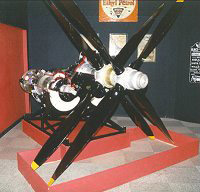
Armstrong-Siddeley Twin Mamba powerplant; author
As the Admiralty realised anti-submarine aircraft could be fitted with far more advanced systems than those used during the war, they changed their requirements and issued GR.17/45 in late 1945. Fairey realised that one of their other projects (an observation aircraft with twin Merlins) would be suitable for carrying the new electronic equipment now available and could be modified to take two Armstrong-Siddeley Mamba turbojets instead of the bulky and outdated Merlins originally planned. Driving two large props, the double Mamba installation soon became an engine in its own right, known imaginatively as the Twin Mamba. While their competitors Blackburns submitted their YA.7 (later YB.1) design to the Admiralty, Fairey applied the final polish to their design, now known as the Type Q. With typical decisiveness in August 1946 the go-ahead was given for prototypes to be built - of both the Blackburn and Fairey machines!
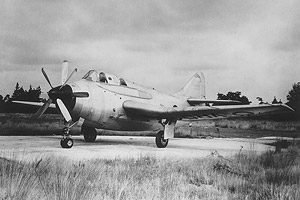
VR546, the Type Q - Gannet prototype, 1949; Fairey Aviation
A little over three years later in September 1949, Fairey's first Type Q prototype - VR546 - was assembled at their plant at Hayes and transported to Aldermaston for its first flight (on the 19th). The rival YB.1 had already flown by this point. Early testing of the Type Q revealed a number of aerodynamic flaws, including large trim changes on flap deployment, mushy elevator response and some directional instability - the first prototype was damaged in a take-off accident due to these issues, being grounded for repairs for 3 months. Relatively minor changes to the elevators, ailerons and rudder soon cleared up most of these problems and deck trials began soon after. In what appeared to be a competition to produce the ugliest aircraft of all time, the Blackburn and Fairey types had now been joined by the Shorts SB.3 - an aircraft of such ugliness that the very air surrounding it recoiled in horror, and thus it had serious problems staying airborne. The first deck landing by a turbo-prop aircraft was made on HMS Illustrious on 19th June 1950 by Lt. Cdr. G. Callingham flying the Type Q VR546. With reports of excellent flying characteristics from all the test pilots, the future for Fairey's new aircraft looked bright. The second prototype was very similar to the first, but had the search radar installed in a retractable radome under the rear fuselage. At this point he Admiralty changed their minds and wanted a larger weapons bay (to accomodate torpedoes), plus an additional cockpit for a dedicated radar operator. The second prototype - VR557 - was already practically complete so a third had to be ordered to be built with a number of significant changes, including the larger weapons bay (extended aft, moving the radome aft in the process), a small increase in wing area (the wing root was moved slightly forward and the innermost section swept back to the first wing fold, with the rear of the wing root unchanged) and a two-seat rear cockpit. By now the aircraft was being called the Type 17, or GR.17.
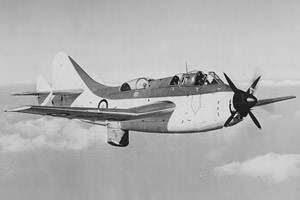
GR.17 WE488 - the third prototype; Fairey Aviation
By the time the third prototype - WE488 - was flying, competitive trials had proven the Fairey type superior to the Blackburn and Shorts efforts, name Gannet had been given to the type and the programme had gained Super Priority status, with an order placed for 100 aircraft. The rear cockpit and radome caused more directional instability when lowered, so Fairey had had to add small finlets to the tailplane - enlarging the tail itself would have been too expensive and would have impacted on the amount of space the aircraft could take up onboard ship. Happily for Fairey the late changes in requirements caused little else in the way of adverse effects, and the loss of the third prototype in an accident did little to delay the building of a production version - the AS.1. Unlike the two-seat Type Q and four-seat GR.17, the AS.1 compromised with three seats. AS.1s began rolling out of the factories in 1953, initially to be used for development flying. One of the first changes made as a result of this was to extend the jetpipe length slightly, as the exhaust gasses were being blown back against the rear fuselage and blackening it. In-service examples would not require regular cleaning of this area as a result.
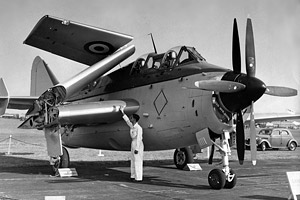
AS.1 on display at the 1953 Farnborough SBAC; Fairey Aviation
The Navy received their first AS.1s at RNAS Ford in April 1954 and intensive trials begin with 703X Flight, whose pilots did not have the luxury of a trainer version and so were finding out about the completely different handling qualities of turboprop engines (most importantly that they did not respond to sudden demands for power in the same way as piston engines). One aircraft was deployed to Egypt for tropical trials as Fairey had had a fair amount of interest from overseas navies, while the RN's first operational Gannet squadron (826 NAS) embarked on HMS Eagle and sailed to the Med. Operational use soon ironed out any remaining difficulties with the engine and airframe, but the Gannet was considered to a little under-powered, particularly in warmer climates and with the increased weapon loads the Admiralty now required.
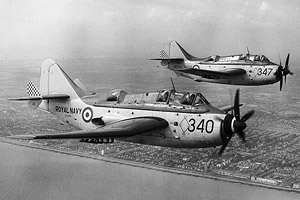
AS.4s XG790 & XA457 of 825 NAS, 1957; Garry Lakin's collection
The need for a trainer had also been recognised and the first T.2 flew in August 1954, with deliveries to the the FAA beginning in early 1955. This differed little in appearance from the AS.1/4, other than having the radome deleted and a periscope installed in front of the second cockpit (so the instructor could see ahead!). An uprated engine was installed in one of the first production AS.1s, making for superior performance and adding an extra safety margin during the critical take-off phase. Test flown in 1956, the resulting aircraft was designated the AS.4 and began entering service later in the year; the AS.1 had by this point only equipped five squadrons, and was entirely replaced by AS.4s by 1958. The T.2 was quickly followed by the T.5 in 1957, an uprated version in the same way that the AS.4 was a more powerful version of the AS.1.
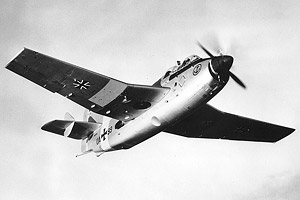
T.5 UA99 for the German Navy, 1958; Fairey Aviation
The German and Australian Navies were highly impressed by the new aircraft and both ordered Gannets in 1956. The Australians even settled for AS.1s, with the intention of exchanging them or converting them to AS.4s when they became available - though this never actually came to pass as the Australians soldiered on with the AS.1s until 1967, when they replaced them with Grumman Trackers. In Australian service the Gannets flew from the carrier HMAS Melbourne and also from the RANAS Nowra shore base. The Germans were content to wait for the AS.4s (which they began receiving in 1958), but to hurry things along Fairey supplied them with AS.4s earkmarked for the RN, and also supplied a T.5 so they could begin pilot training before the AS.4s arrived. In German service with Marinefliegergeschwader 1 (MFG 1) the Gannet was shore-based at Schleswig (later Nordholz) and their primary job was patrolling the Baltic, until replaced by helicopters in 1966.
The Gannet's only other export order came from Indonesia in 1959 - a number of the now-retired AS.1s and T.2s were bought back from the Ministry of Supply to be converted to AS.4s and T.5s and sold to Indonesia. Interest from other nations died away as the submarine threat seemed ever less likely to countries now beginning to recover from the devastation of WWII. A single Gannet deployed to Canada for trials with the RCN but though impressed with the aircraft, the Canadians decided not to buy any and chose the Grumman Tracker instead.
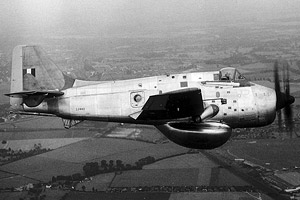
AEW.3 prototype XJ440; Fairey Aviation
Prior to the AS.4 in number order but delayed by difficulties with development was an Airborne Early Warning variant, the AEW.3. Initially intended to be an AS.1 with the minimum modifications to carry radar equipment cannibalised from the RN's Skyraiders, this turned out to be impossible and a new fuselage was required. The AN/APS 20 radar was to be mounted in a radome underneath the centre fuselage and room would be made for an operator's position by deleting the second cockpit and moving the exhausts forward of the wing. A larger tail was necessary to combat the instability caused by the bulbous radome. Finally flying in August 1958, trials were carried out with HMS Centaur in November and in December the RN received the first production AEW.3. Initially lukewarm to the AEW idea, the Admiralty soon realised the usefulness of such a type when it was realised the new Buccaneer strike aircraft could easily sneak up on a carrier task force and would be detected far too late with ship-based radars.
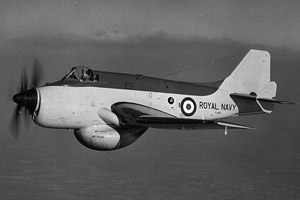
AEW.3 XL455; author's collection
As more AEW.3s came off the production line more trials were carried out and in August 1959 700G Intensive Trials Unit was formed, continuing the FAA's tradition of forming a trials unit for each new type introduced into service to accelerate service acceptance. As the AEW.3 was being introduced into service, helicopter development had surged ahead of its initially underpowered beginnings, and the Admiralty soon saw how superior the helicopter could be - not only could they carry out the anti-submarine mission (and, unlike a Gannet, loiter over a suspected submarine position giving it little chance to escape) but they also didn't require large carriers and could carry out many other duties. As a result the AEW.3 would become perhaps the definitive Gannet variant, with the relatively short-lived anti-submarine variants more or less disappearing from the scene and the AEW aircraft becoming a common sight and staying in service for many years.
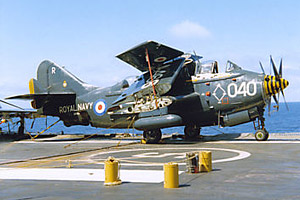
COD.4 XA466, HMS Ark Royal, 1971; author's collection
By mid 1960 the anti-submarine-tasked Gannets were all replaced by the Westland Whirlwind in RN service, but some AS.4s survived to carry out other duties, with considerable modifications and additions to the aircraft's electronics suite, giving them the capability to gather signals intelligence and perform a certain amount of communications and radar jamming - primarily to train RN personnel in how to deal with electronic warfare. These aircraft were generally shore-based, and rarely went to sea. Initially retaining their AS.1 or AS.4 designations, they were later designated AS.6s, and commonly referred to as the ECM.6. Another minor variant that stayed in service was the COD.4 - AS.4s modified to become a rather basic transport (COD = Carrier Onboard Delivery) by removing much internal equipment to free space for extra seats or cargo. These were busy aircraft, acting as taxis for high ranking officers as well as carrying out that most important of naval resupply missions - delivering everybody's mail!
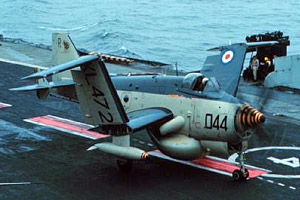
AEW.3 XL472, HMS Ark Royal, mid 1970s; John Eacott
Just as the AEW.3 Gannet was proving to be one of the most useful aircraft the RN had ever operated, including backing up the RAF and Army on numerous occasions by providing AEW for those services, the UK suffered a change of government in 1964. While a replacement for the Gannet AEW.3 was planned and would be very necessary in the next decade, the new government cancelled all these plans along with the Navy's new large carrier CVA-01 and numerous other planned defence projects (including of course the TSR.2). Plans to keep the Gannet in operation for much longer than initially intended were put into place and the AEW.3s and a small number of COD.4s remained in service until more defence cuts from another government spelt the end of the RN's carrier force. The Gannets were flown to Lossiemouth, most to be scrapped. The radars were rescued and used by the RAF's Shackleton force for land-based AEW (bear in mind these same radars had been fitted to Skyraiders way back in the 1950s!) but the RN was now without any form of airborne early warning.
The summer of 1982, less than 4 years after the retirement of the last AEW Gannet, soon showed the folly of this retirement, with several RN ships lost to low level Argentine attacks during the Falklands War. AEW coverage would almost certainly have saved these ships - and the sailors who lost their lives because of short-sighted defence cuts. Only after the Falklands War did the Royal Navy get back some AEW capability in the shape of hastily converted Sea King helicopters equipped with basic radar sets (similar to the sets used in RAF Nimrods, and not entirely suitable for the task). It took until 2002 for more modern and effective radars to be installed on these Sea Kings - so a full 24 years had passed before the RN got back AEW cover that was as effective as that provided by the Gannet.
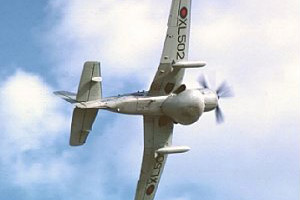
AEW.3 XL502 displaying, May 1988; Garry Lakin
After retirement from RN service, four Gannets enjoyed fairly brief periods of civilian utilisation, AEW.3 XL482 being refurbished in 1982 and sold to Hamilton Standard in the USA and flying during 1983 for propeller vibratory stress trials; AEW.3 XL500 flying for Dowty-Rotol until the mid-1980s for propeller development and noise trials (and currently being restored to flight once more at Exeter); AEW.3 XL502 was flown by a private owner on the UK airshow circuit until the late 1980s and the prototype T.5 (and T.2), XT752 was exported to the US in 1995, restored and flown on the airshow circuit there until 1999. An attempt was made in 2004 to return this aircraft to the UK, but degenerated into a messy legal wrangle with the aircraft being stranded in Goose Bay in Canada for 6 years before returning to the USA, where she took to the air once again in 2013. Another restoration to flight is currently underway in the UK with AEW.3 XL500.
Leading Particulars
| Variant | Type Q | AS.1 | T.2 | AEW.3 | AS.4 | COD.4 | T.5 | ECM.6 |
|---|---|---|---|---|---|---|---|---|
| First flight | 19 Sep 1949 | 9 Jun 1953 | 16 Aug 1954 | 20 Aug 1958 | 12 Mar 1956 | ? | 1 Mar 1957 | ? |
| Crew | 2 | 3 | 2 or 3 | 3 | 3 | 2 + 1 passenger | 2 or 3 | 3 |
| Armament | None | 2,000 lb of torpedoes, mines, rockets & depth charges | Usually none | As AS.1 | None | As AS.1 | None | |
| Powerplant | ASMD.1 2950 shp Twin Mamba | ASMD.8 3700 shp Twin Mamba | ASMD.3 3035 shp Twin Mamba | |||||
| Max. speed (sea level) | ? | 310 mph | 308 mph | 299 mph | ||||
| Service ceiling | ? | 25,000 ft | ||||||
| Range | ? | 600 nm | 700 nm | 575 nm | ||||
| Empty weight | ? | 15,069 lb | ? | 14,528 lb | ||||
| Max. take off weight | ? | 19,600 lb | 26,000 lb | 23,446 lb | ||||
| Wing span | 54 ft 4 in | 54 ft 7 in | 54 ft 4 in | |||||
| Wing area | ? | 483 sq ft | ? | 483 sq ft | ||||
| Length | ? | 43 ft | 44 ft | 43 ft | ||||
| Height | ? | 13 ft 9 in | 16 ft 9 in | 13 ft 9 in | ||||
| Production | 3 | 181 | 38 | 45 | 75 | 6 | 11 | 9 |
Production figures for T.2 includes one AS.1 conversion; for AEW.3 includes one prototype; for AS.4s includes one AS.1 conversion; all COD.4s and ECM.6s were AS.4 conversions; for T.5 includes three T.2 conversions.
